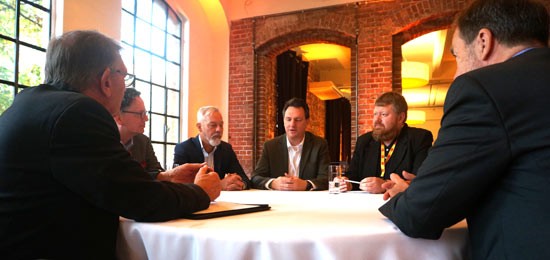A wide range of newspaper formats is just one of the crosses printers in the European newspaper market have to bear – and for some, the choice of solutions is simple.
Keynote speaker on the first day of WAN-Ifra’s European Printers Summit Paul Huybrechts advocated standardising across your own stable of publications and contract work – which brings “acknowledged benefits” – or live with it.
Huybrechts, who is print and distribution director of Belgian-hedquartered Mediahuis – with operations also in Belgium, the Netherlands and shortly, northern Germany, told attendees that, while they can combine all formats on one machine, it “is a matter of web widths because cut-offs cannot be changed.”
He advised “playing around” with formats and standardising contract work as much as possible, with publishers accepting that some trimming and paper waste is inevitable.
“If you cut the base costs very low, the customer will pay the costs of waste paper,” he said.
The issue of formats again came up for discussion at a printers’ ‘round table’ on the second day, with a look at initial results of the World Printers Forum ‘outlook survey’ for 2021-2022, with the group agreeing that while other markets including the UK and Scandinavia had “done a great job” standardising formats to tabloid, Germany was still dealing with all the issues that multiple formats bring.
Bertram Stausberg of Axel Springer Print Management confirmed that the publisher of market leader Bild would not hear of changing format from the ‘Nordische’ broadsheet, “so we have to live with it”.
Maybe not for ever, however: Moderater and former WAN-Ifra director Manfred Werfel said the format was declining in Germany, with circulations going down faster than those of tabloid format.
Thomas Sandstrom of Swedish printing group VK Media reported that their major customers all wanted to print tabloid in order to save money on shared transport, with the result that they all want the 6pm print slot “and we have to stretch it a bit”.
First results of the survey indicate that 70.5 per cent of respondents expected more revenue in 2021/2022 than the previous year; almost half said their headcount would remain the same; and the 55 per cent who undertook commercial printing work were seeking more.
Almost 70 per cent had reported they planned new or retrofit investments this year, in line with the views of round table participants that “only starting from scratch and putting in a new press” would save worthwhile cash, while investing in CTP software and hardware, press automation and inking control systems would bring quality and financial benefits over the shorter term.
Werfel said different situations in different countries affected investment strategies.

Almost a quarter of survey respondents (23 per cent) had voted for bundling investments, with Bengt Föbker of Pressedruck Potsdam reporting that a change of bundling equipment to Flexpack had enabled smaller bundles and better handling of inserts.
The group agreed that investment in ink control systems for older presses had been important, “along with automation generally”.
The face-to-face event in Frankfurt continued with round table discussions on innovations in prepress and talent building.

















Comments